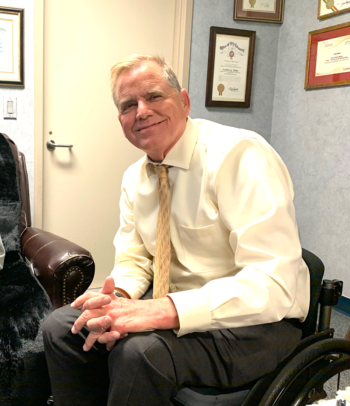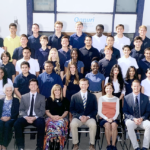 By Michael Ashcraft and Nazarii Baytler —
By Michael Ashcraft and Nazarii Baytler —
Andy Bales’ leg was amputated in 2016 after he contracted an infection related to homeless people defecating on LA’s Skid Row.
While politicians dicker about who’s to blame for the city’s acute homelessness crisis, Andy, CEO of Union Rescue Mission, believes they have the answer that manifests Christ’s love in a pragmatic way. It’s called a Sprung Structure, a cheap and durable fabric tent that can house 120 people.
“The answer is IMMEDIATELY getting people off the streets so they are not continuing to be devastated,” he says. “The longer we leave so many people on the streets, the worse it gets for them and for all of us.”
In 2014, Andy participated in a triathlon and scraped open a sore on his foot. He was wearing a “wound boot” when he walked around with staff handing out bottled water and invited people to take advantage of Union Rescue Mission’s services.

“I got an infection from human waste outside on the sidewalk on Skid Row,” he says.
Right now, there are only nine public toilets to service 2,800 people on Skid Row. The numbers don’t add up and actually fall short of toilets available for refugee camps in Syria (the refugees have it better). He calculates 184 toilets would be needed to keep the homeless from defecating and urinating on the sidewalk.
He describes a dangerous situation with grave infections happening to people all the time. Aside from cleaning the street every two weeks, the City hasn’t done much, he says.
Los Angeles’ homeless crisis is worse than New York’s or San Francisco’s. Last year, there were 41,000 on the streets. This year, there are 44,000, Andy says.
Andy, 61, is no Ivory Tower theorist. He’s a man of the trenches.
 To remind himself and draw attention to the plight of the homeless, Andy spends New Year’s Eve on the streets every year. He denies himself his bed, his warm room, his shower, his bathroom, and his dinner. He spends the entire night outside, with whoever volunteers to help him, on the streets.
To remind himself and draw attention to the plight of the homeless, Andy spends New Year’s Eve on the streets every year. He denies himself his bed, his warm room, his shower, his bathroom, and his dinner. He spends the entire night outside, with whoever volunteers to help him, on the streets.
The first time he did it many years ago, he did it alone. Throughout the night, he broke up fights and fought off rapists — five physical altercations in total, he says. Never again would he brave the streets alone. Sometimes he’s accompanied by Bible college students, sometimes by staff.
So he experiences firsthand the horrors of homelessness. When the news reports of violence and even murder perpetrated by the homeless, Andy knows what goes wrong.

“I don’t know how anyone continues to sleep on the streets night after night without beginning to think in a wrong way,” he says. “I’m still recovering two days later. You can see I have a shake in my hands. And that was just one night. I can’t survive one night on the streets. How can I survive two. Or how could I survive weeks or months or decades on the streets?”
Of the L.A. population, 1% is homeless.
The homeless represent 17% of homicide victims.
“They are completely vulnerable to danger and homicide,” Andy warns.
More homeless die of hypothermia in Los Angeles than in New York and San Francisco combined, he says. That’s because New York built shelters while LA spent its money arguing before the Supreme Court a case it lost to criminalize homeless camping in city limits, Andy says.
The Supreme Court ruled that you can’t force people off the streets unless there are shelter beds for them to go to, he says.

The City of New York puts a roof over the heads of 95% of its homeless population. LA has only 16,000 shelter beds and needs 44,000 more to meet the current need, he explains.
Union Rescue Mission on Skid Row houses 1,250 of the homeless at its downtown facility and another 250 at its Hope Gardens facility for moms, kids and senior women. Founded in 1891 by Union Oil’s president George Hilton, the Union Rescue Mission is one the largest shelters nationwide.
Ten times more people die from complications resulting from homelessness in LA than die from all natural disasters in the State, he says.
Each day, 3-4 homeless people die, he says.
Every day, 150 people become homeless. Only 133 get assistance daily.
If radical action is not taken, Andy predicts that L.A.’s homeless population will swell to more than 80,000 by the time Los Angeles hosts the Olympics in 2028.
With camping tents and makeshift tent s, the homeless are taking over more and more sidewalks, underpasses and parks around Los Angeles, creating danger for kids and joggers and an eyesore for tourists, who are generally overwhelmed to see the City of Glitz besmirched and tarnished.
s, the homeless are taking over more and more sidewalks, underpasses and parks around Los Angeles, creating danger for kids and joggers and an eyesore for tourists, who are generally overwhelmed to see the City of Glitz besmirched and tarnished.
Los Angeles is the only city that leaves 75% of its homeless on the streets, Andy says.
“We need to change the way we are approaching this problem,” he says. “I want us to treat it like the FEMA-like disaster that it is and bring in help and get people into triage, get a roof over their heads like our Sprung structure.” (FEMA is the Federal Emergency Management Agency that administers federal funds for hurricanes and the like.)
Andy says LA Mayor Eric Garcetti wants to erect 88 of the 250,000 square foot microfiber tents around L.A., but he’s run into problems getting funds from the county. Perhaps worse, Mayor Garcetti faces opposition from Housing and Urban Development officials left over from the Obama administration who believe everyone deserves a $500,000 unit for free.

“I call it far-in-the-future imaginary housing,” Andy says. “I don’t believe we can solve the issue with $500,000 per unit per person. It takes too long. It costs too much. We’ll never get there. We need immediate shelter and innovative affordable housing like container homes, tiny homes, mobile homes.”
How do HUD officials concoct policy that rewards people with free housing for no work?
“It’s the philosophical dogmatic approach that HUD and activists have taken,” Andy says. “Those are the folks that believe everybody deserves a very expensive unit and in that unit you should be allowed to use alcohol and drugs, that your personal behavior shouldn’t be interfered with in any way. It almost enables or empowers addiction.”
“They think any money wasted on a shelter doesn’t go towards that housing, so they’d rather leave 44,000 on the streets until that housing can be eventually built.”
Andy got saved listening to the parable of Lazarus and the Rich Young Ruler. He was only five. He grew up in Christianity, became a youth pastor, a Christian schoolteacher and eventually a director of Christian rehab/shelter in Des Moine, Iowa.
Andy is married to Bonnie Bales, with whom he has six kids and seven grandkids. He moved to L.A. 20 years ago and originally attended the Lake Avenue Church in Pasadena, where he advocated for the homeless until they tired of him, he says.
He might have called it quits to his ministry to the homeless at Union Rescue Mission. But no, he continues wheeling around in his wheelchair as motivated as ever.
 “I’d give my other leg if they would actually do something” to get people off the streets, he declares.
“I’d give my other leg if they would actually do something” to get people off the streets, he declares.
Nazarii Baytler studies journalism at the Lighthouse Christian Academy, where Michael Ashcraft is his teacher.



